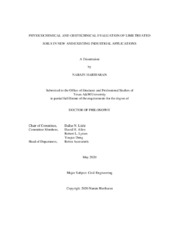| dc.description.abstract | Lime products (quicklime, hydrated lime and quick or hydrated lime slurry) have been widely studied and effectively used for chemical stabilization of expansive subgrade soils beneath roadways. However, several unanswered questions remain regarding the long-term durability of lime treatment and the nature of chemical interactions between lime and the soil minerals in new and less common industrial applications. The emphasis of this work is to evaluate the use of lime products for two such applications; the treatment and management of the Canadian oil sands fluid fine tailings (FFTs) having solids concentrations by mass of about 30%, and the treatment of soils used in the construction of hydraulic structures in permanent contact with water. In addition, modifications are proposed to two existing methods used for characterizing the volumetric stability of expansive soils to account for the changes in material properties due to lime treatment and ultimately improve the design of roadways built on expansive soils.
First, a physicochemical and geotechnical evaluation is performed on hydrated lime slurry treated FFTs after dewatering them using a decanter centrifuge or a benchtop pressure filter to obtain a solids fraction comprising of 55% to 70% solids by mass. The results demonstrate three unique benefits of lime over other calcium-based coagulants and polymeric flocculants; the ability to increase pH and enhance clay capture within the solids and clarify the release water, the ability to deplete carbonate phases up to a pH of 11.5, and the ability to produce a material with undrained shear strengths in excess of 100 kPa within 28 days suitable for reclamation. A numerical model is developed using the experimental results to predict the liquidity index and shear strength of lime treated FFT solids over the first 180 days.
Next, a case study is conducted to evaluate the durability of nearly 50-year-old lime treated sections at the Friant-Kern canal in a similar manner to the oil sands application but considering the impact of leaching and carbonation due to environmental factors. The results indicate minimal leaching of lime over time and demonstrate the benefits of lime towards increasing strength of the soils through pozzolanic reactions, reducing soil erosion and mitigating expansion by improving drainage characteristics due to textural modification of the clays to lean silts.
Finally, two modifications to existing methods are proposed to understand the true impact of lime treatment on reducing the vertical movement in roadways due to expansive soils; the first using the soil water characteristic curve to define the initial moisture state of soils in the Tex-124-E method, and the second using the packing arrangement of soil particles to define a shift factor to relate the suction compressibility index of reconstituted and intact soils. | en |


